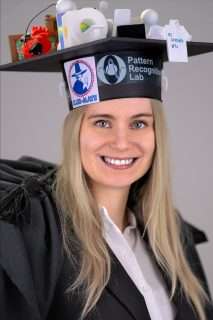Elisabeth Preuhs
Acquisition and Reconstruction Methods for Multidimensional and Quantitative MRI
Magnetic Resonance Imaging (MRI) is a tomographic imaging technique using the principles of nuclear magnetism of mostly the hydrogen nuclei, which are largely contained in the human body. This allows for insights to the interior tissue distributions. While its non-ionizing nature is advantageous compared to, e.g., Computed Tomography, standard MRI only yields qualitative data allowing to discriminate different tissue boundaries without providing quantitative values. To enable quantitative MRI, multiple dimensions, i.e., spatial voxels and different physiological modes, e.g., cardiac and/or different contrast phases, have to be acquired simultaneously for a comprehensive diagnosis. From such data, dynamically resolved volumes can be reconstructed, allowing the assessment of quantitative biomarkers from different imaging contrasts. In this thesis, we investigated novel and extended solutions for multidimensional and quantitative MRI. The proposed methods were trained and evaluated on phantom data, as well as on several acquired in-vivo data sets from in total 49 volunteers.
First, we devised a Deep Learning (DL)-based reconstruction approach for Magnetic Resonance Fingerprinting (MRF) acquisitions. MRF acquires several highly undersampled imaging contrasts of the same slice by randomly changing the sampling parameters, resulting in temporal sequences for each spatial position. Our proposed framework uses spatial patches of these sequences as input and regresses them to quantitative relaxation T1 and T2 values. The results showed that the DL-based reconstruction yields accurate results well comparable to the State-of-the-Art (SOTA) reconstruction while reducing the computational effort during runtime.
We extended a 3-D cardiac sequence to sample single-contrast (SC) data with cardiac and respiratory phases continuously. Repetitive Inversion Recovery (IR) preparation pulses were further inserted to enable the sampling of multi-contrast (MC) continuous data on the T1 relaxation curve. A Cartesian pseudo-spiral sampling was used to enforce a pseudo-random undersampling pattern for the subsequent Compressed Sensing (CS)-based reconstruction. We proposed a pipeline which binned acquired data samples into different anatomic and contrast phases prior to the CS reconstruction. The T1 relaxation values fitted from different contrast bins were shown to be well comparable with the ground-truth (GT) values, as well as with a SOTA T1 mapping sequence in a quantitative phantom.
Lastly, we proposed motion extraction and binning pipelines towards an in-vivo application of the continuous SC and MC sequences for cardiac MRI. A DL-based classifier was used to determine the R-waves directly from the acquired imaging data to bin all samples into different cardiac phases. The extracted R-waves were comparable to the R-waves from the SOTA Electrocardiogram (ECG)-sensor for both SC and MC in-vivo data, but without the use of an additional sensor. Moreover, our DL-based approach recognized R-waves that were not detected by the ECG-sensor due to its interference with the magnetic field. Further, we proposed frameworks for extracting the respiratory motion directly from the acquired data, either from central 1-D projections, or from low-resolution 2-D images with an adapted version of the sampling scheme. Our results showed that the pipelines can be used for both types of cardiac in-vivo SC and MC data with the same set of parameters. Further, the image quality for all reconstructions could be improved with the utilization of the pipelines and the reconstruction of data samples from one respiratory phase.
